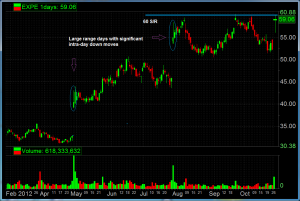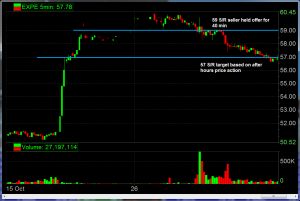Trading is about having a series of if/then statements and not about making predictions. In practical terms this means that traders are game planning for every stock on their watch list. They are making decisions on how to trade each name based on price action, market conditions and news catalysts. For every stock I look at each day I have an understanding of what conditions would lead me to make a long trade, short trade or no trade. By developing these ideas in advance it makes it easier to execute in real time as additional data is being presented.
Let’s take a look at EXPE from today. This is a stock in a longer term uptrend that has had a series of news catalysts that led to large gaps since April. A few things stand out to me on the longer-term chart. The first is that this stock has failed two times to breakout above 60. The second is that on two prior large gaps the stock sold off significantly from its intraday high. I use these observations to help formulate my if/then statements for how to handle potential trades.

Then I look at the lower time frame chart that includes price action after the earnings number is released and also look at the price action from today’s pre-market to give me additional clues for potential entry points. I notice that it is consolidating in the pre-market above the after hours high which is evidence of a possible breakout above 60. I also understand that some longs may become antsy on a failed drive above 60 on the Open so that if there is a strong down move below 59 and then sellers emerge holding the 59 level I may see a down move to the next support area at 57.

Watch this short clip from today’s AM Meeting where I explained my thought process for entering a short trade below 59.
EXPE was holding below 59 this morning for about 30 minutes before sellers became more aggressive pushing it below the opening low of 58.22. This price action would lead me to create a series of if/then statements to assist me in executing a short trade. As an experienced trader I formulate these statements at a subconscious level but easily can state them if a trader were to ask me how I would manage the trade. It is important for younger traders to spend time writing these out until they become second nature.
Here are a few examples:
IF sellers hold the 59 offer for more than 10 minutes THEN I will get short;
IF sellers push EXPE below 58.22 Then I will add a momentum lot;
IF EXPE fails to hold below 58 within 10 minutes THEN I will cover 50% of my position;
IF EXPE trades below 58 and I can identify sellers at this level THEN I will add one lot to this position;
IF after shorting EXPE below 58 it THEN trades above 58.22 I will reduce my position size
For every trade you are involved in you can have literally dozens of if/then statements from your pre-trade plan all the way through your exiting of a position. This may be part of the reason why trading on the lowest time frame requires the greatest amount of discipline and is the most difficult to achieve consistent profitability.
Let’s take a look at EXPE from today. This is a stock in a longer term uptrend that has had a series of news catalysts that led to large gaps since April. A few things stand out to me on the longer-term chart. The first is that this stock has failed two times to breakout above 60. The second is that on two prior large gaps the stock sold off significantly from its intraday high. I use these observations to help formulate my if/then statements for how to handle potential trades.

Then I look at the lower time frame chart that includes price action after the earnings number is released and also look at the price action from today’s pre-market to give me additional clues for potential entry points. I notice that it is consolidating in the pre-market above the after hours high which is evidence of a possible breakout above 60. I also understand that some longs may become antsy on a failed drive above 60 on the Open so that if there is a strong down move below 59 and then sellers emerge holding the 59 level I may see a down move to the next support area at 57.

Watch this short clip from today’s AM Meeting where I explained my thought process for entering a short trade below 59.
EXPE was holding below 59 this morning for about 30 minutes before sellers became more aggressive pushing it below the opening low of 58.22. This price action would lead me to create a series of if/then statements to assist me in executing a short trade. As an experienced trader I formulate these statements at a subconscious level but easily can state them if a trader were to ask me how I would manage the trade. It is important for younger traders to spend time writing these out until they become second nature.
Here are a few examples:
IF sellers hold the 59 offer for more than 10 minutes THEN I will get short;
IF sellers push EXPE below 58.22 Then I will add a momentum lot;
IF EXPE fails to hold below 58 within 10 minutes THEN I will cover 50% of my position;
IF EXPE trades below 58 and I can identify sellers at this level THEN I will add one lot to this position;
IF after shorting EXPE below 58 it THEN trades above 58.22 I will reduce my position size
For every trade you are involved in you can have literally dozens of if/then statements from your pre-trade plan all the way through your exiting of a position. This may be part of the reason why trading on the lowest time frame requires the greatest amount of discipline and is the most difficult to achieve consistent profitability.
No comments:
Post a Comment